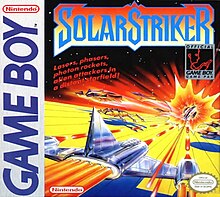Solar Striker
| SolarStriker | |
|---|---|
 Box art | |
| Developer(s) | Nintendo R&D1 Minakuchi Engineering |
| Publisher(s) | Nintendo |
| Director(s) | Satoru Okada Keisuke Terasaki[1] |
| Producer(s) | Gunpei Yokoi[1] |
| Designer(s) | K. Hayashi A. Higashiya K. Katsuyama K. Yamagami[1] |
| Programmer(s) | K. Sugimoto[1] |
| Composer(s) | Toru Osada[2] |
| Platform(s) | Game Boy |
| Release | |
| Genre(s) | Scrolling shooter |
| Mode(s) | Single-player |
Solar Striker[a] is a vertically scrolling shooter video game developed by Nintendo and Minakuchi Engineering and published by Nintendo for the Game Boy. It was first published in Japan in January 1990, then released later in North America in February 1990 and in Europe on September 1990.
Plot
[edit]This section needs expansion with: Please write an original plot summary without direct copying and pasting. You can help by adding to it. (September 2024) |
Gameplay
[edit]
The player controls the advanced space fighter, code-named Solar Striker. There are six levels of play against enemies known as the forces of Reticulon. These enemies appear from the top of the screen. The player can amass power-ups by shooting special ships. One power-up doubles the player's firepower, three power-ups triples the player's firepower, and five power-ups causes shots to explode on impact with enemies, greatly aiding combat against tough enemies and bosses that take many hits to destroy. There are a variety of enemies as well as sub-bosses in later levels. When the player completes all six levels for the first time and after the credits roll, the player will be able to play Hard Mode by pressing Select instead of Start from the title screen.
Development
[edit]Solar Striker was designed by Gunpei Yokoi and Keisuke Terasaki,[1] and developed by Nintendo in co-operation with the external company Minakuchi Engineering. It was first published in Japan on January 26, 1990, then released later in North America in February, and in Europe on September 28. As such, it is one of the few scrolling shooters developed by Nintendo.
Reception
[edit]Solar Striker has been met with generally favorable reviews. It earned an overall score of 75% at GameRankings. Mean Machines described Solar Striker as "adequate", but noted there was a lack of material to keep players interested, giving the game a score of 69%.[3] Allgame rated it 2.5/5, describing it as a "decent shooter but nothing great", and citing its difficulty as a deterrent to enjoying it.[4] Games Are Fun gave it a 7 out of 10. German magazine Power Play praised the title for its variety in terms of enemies and levels, though noted the underlying simplicity of the game as well, giving it a score of 70%.[5]
Author Jeff Rovin in the book How to Win at Game Boy Games described the title as "one of the oldest kinds of Nintendo games", comparing it to SNK's Alpha Mission but added there were too few instances of innovation or surprises, and the powerups were "unsatisfying".[6]
Legacy
[edit]The background music for Level 1 and Level 2 was used in the beginning of the Captain N: The Game Master episode, "The Trouble With Tetris", in a slightly altered form. A space craft seen in the same part of the episode resembles the Solar Striker on the Japanese box art of the game. The Level 1 background music was also used in later season 2 episodes of Captain N: The Game Master.
Notes
[edit]- ^ Japanese: ソーラーストライカー
References
[edit]- ^ a b c d e "N-Sider.com: Solar Striker". N-Sider. December 24, 2007. Archived from the original on March 3, 2016. Retrieved December 24, 2007.
- ^ Mobygames
- ^ Rignall, Julian; Matt Regan (November 1990). "Solar Striker Review". Mean Machines (7). Retrieved June 4, 2009.
- ^ Sutyak, Jonathan. "SolarStriker - Review". Allgame. All Media Group. Retrieved June 4, 2009.
- ^ "Solar Striker for Game Boy - MobyRank". MobyGames. Retrieved June 4, 2009.
- ^ Rovin, Jeff (1991). How to Win at Game Boy Games. Signet Books. p. 160. ISBN 0-451-17446-1.
External links
[edit]- 1990 video games
- Game Boy games
- Game Boy-only games
- Minakuchi Engineering games
- Nintendo Research & Development 1 games
- Science fiction video games
- Shoot 'em ups
- Single-player video games
- Vertically scrolling shooters
- Video games developed in Japan
- Video games directed by Satoru Okada
- Video games produced by Gunpei Yokoi
- Video games set in the 22nd century
- Nintendo games
